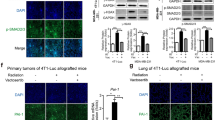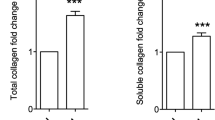Abstract
Fibrosis in normal tissues is a common and dose-limiting late complication of radiotherapy at many cancer sites, but its pathogenesis is poorly understood. We undertook a controlled study of the effect of irradiation on the collagen production of fibroblasts cultured from skin biopsies taken from patients undergoing radiotherapy treatment. Eight weeks after a single 8 Gy fraction using 300 kV X-rays, five patients treated at the Royal Marsden Hospital underwent biopsy of the irradiated site and of the contralateral, unirradiated body site. Fibroblasts from irradiated and control, unirradiated sites were cultured in vitro, and collagen production rates were measured during a 48-hour incubation under standardized conditions and in the presence and absence of transforming growth factor β1(TGF β1), 1 ng/ml, using HPLC. Collagen production was elevated in cells cultured from irradiated skin; median collagen production rates 61.16 pmoles hydroxyproline/105cells/hour in irradiated cells, 39.78 pmoles hydroxyproline/105cells/hour in unirradiated cells, P = 0.016 (Mann–Whitney U-test). In fibroblasts from unirradiated sites, collagen production rates were increased by the addition of TGF β1; however, in three of the cell lines cultured from irradiated sites this effect of TGF β1on collagen production was not observed. © 2000 Cancer Research Campaign
Similar content being viewed by others
Article PDF
Change history
16 November 2011
This paper was modified 12 months after initial publication to switch to Creative Commons licence terms, as noted at publication
References
Autio P, Saarto T, Tenhunen M, Elomaa I Risteli J & Lahtinen T (1998) Demonstration of increased collagen synthesis in irradiated human skin in vivo. Br J Cancer 77(12): 2331–2335
Barcellos-Hoff MH (1993) Radiation-induced transforming growth factor β and subsequent extracellular matrix reorganization in murine mammary gland. Cancer Res 53: 3880–3886
Campa JS, McAnulty RJ & Laurent GJ (1990) Application of high pressure liquid chromatography to studies of collagen production by isolated cells in culture. Anal Biochem 186: 257–263
Canney PA & Dean S (1990) Transforming growth factor beta: a promoter of late connective tissue injury following radiotherapy?. Br J Radiol 63: 620–623
Cotton SA, Herrick AL & Jayson MV Freemont of AJ (1998) TGF β – a role in systemic sclerosis?. J Pathol 184: 4–6
El Nabout R, Martin M, Remy J, Kern P, Robert L & Lafuma C (1989) Collagen synthesis and deposition in cultured fibroblasts from subcutaneous radiation-induced fibrosis. Modification as a function of cell aging. Matrix Biol 9: 411–420
Finkelstein JN, Johnston CJ, Baggs R & Rubin P (1994) Early alterations in extracellular matrix and transforming growth factor β gene expression in mouse lung indicative of late radiation fibrosis. Int J Radiat Oncol Biol Phys 28 (3): 621–631
Kolb M, Wruck R, Rollin J, Kirschner J, Willner J & Schmidt M (1998) Lung fibroblasts produce high amounts of fibronectin after irradiation. Am J Respir Crit Care Med 157: A 846
McAnulty RJ, Campa JS, Cambrey AD & Laurent GJ (1991) The effect of transforming growth factor β on rates of procollagen synthesis and degradation in vitro. Biochemica et Biophysica Acta 1091: 231–235
McAnulty RJ, Chambers RC & Laurent GJ (1995) Regulation of fibroblast procollagen production. Biochem J 307: 63–68
Moulin V, Auger F, O’Connor-McCourt M & Germain L (1997) Fetal and postnatal sera differentially modulate human dermal fibrobast phenotypic and functional features in vitro. J Cell Physiol 171: 1–10
Ormerod MG (1990). Flow cytometry. A practical approach, IRL Press (Oxford University Press)
Randall K & Coggle JE (1996) Long-term expression of transforming growth factor TGF β1in mouse skin after localized β-irradiation. Int J Radiat Biol 70(3): 351–360
Rodemann HP & Bamberg M (1995) Cellular basis of radiation-induced fibrosis. Radiother Oncol 35: 83–90
Rubin P & Cassarett GW (1968). Clinical Radiation Pathology, Philadelphia: W.B. Saunders Company
Rudolph R, Vande-Berg J, Scheider JA, Fisher JC & Poolman WL (1988) Slowed growth of cultured fibroblasts from human radiation wounds. Plast Reconstr Surg 82(4): 669–677
Zhang D & Jacobberger JW (1996) Perturbation of cell cycle by TGF β1 . Cell Prolif 29: 289–307
Author information
Authors and Affiliations
Rights and permissions
From twelve months after its original publication, this work is licensed under the Creative Commons Attribution-NonCommercial-Share Alike 3.0 Unported License. To view a copy of this license, visit http://creativecommons.org/licenses/by-nc-sa/3.0/
About this article
Cite this article
Illsley, M., Peacock, J., McAnulty, R. et al. Increased collagen production in fibroblasts cultured from irradiated skin and effect of TGF β 1– clinical study. Br J Cancer 83, 650–654 (2000). https://doi.org/10.1054/bjoc.2000.1321
Received:
Accepted:
Published:
Issue date:
DOI: https://doi.org/10.1054/bjoc.2000.1321
Keywords
This article is cited by
-
Topical Fibronectin Improves Wound Healing of Irradiated Skin
Scientific Reports (2017)
-
An expression analysis of markers of radiation-induced skin fibrosis and angiogenesis in wound healing disorders of the head and neck
Radiation Oncology (2015)
-
Effects of 900 MHz Radiofrequency Radiation on Skin Hydroxyproline Contents
Cell Biochemistry and Biophysics (2014)
-
Wound healing after radiation therapy: Review of the literature
Radiation Oncology (2012)



